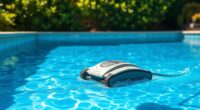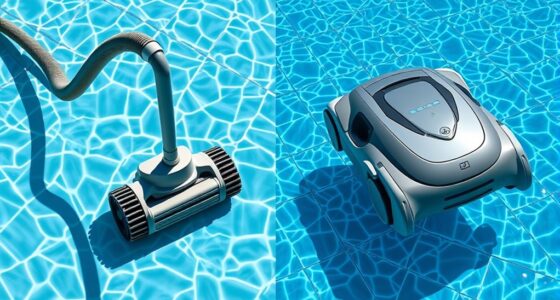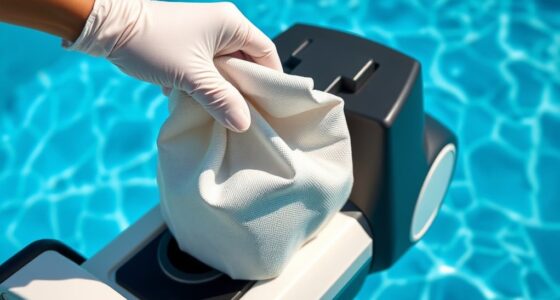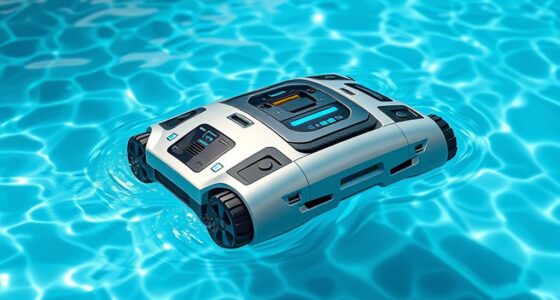If your robotic pool cleaner isn’t working well, start by checking the power supply and charger for damage or connection issues. Make certain the device’s filters and brushes are clean and free of debris. Verify the sensor and path are clear, and that the robot is placed properly in the pool. Reset the unit or update its firmware if needed. If problems persist, reviewing detailed troubleshooting steps can help you get back to a spotless pool efficiently.
Key Takeaways
- Check and clean power connections, filters, brushes, and sensors regularly to prevent performance issues.
- Ensure the robot is correctly placed with a clear path free of debris and obstructions.
- Verify battery charge and inspect charging station placement for proper charging.
- Reset the device and update firmware or app to fix software glitches.
- Consult the user manual or contact customer support for persistent or complex problems.
Check and Clean the Power Supply and Charger
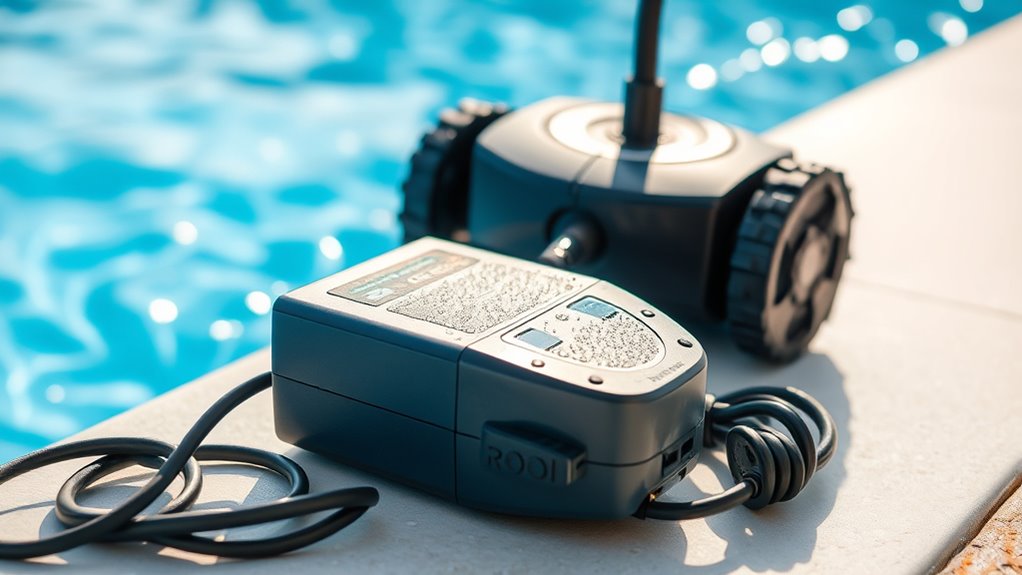
Have you checked whether your robotic pool cleaner’s power supply and charger are functioning properly? Power supply issues are a common cause of operational problems. Start by inspecting the power cord and connections for damage or loose plugs. Ensure the outlet is working by plugging in another device. Charger maintenance is equally important; clean the charger contacts to remove dirt or corrosion that could hinder charging. If the charger isn’t providing power, try using a different outlet or test with a replacement charger if available. Sometimes, the problem lies with the power supply unit itself, which may need professional repair or replacement. Regularly maintaining your charger and verifying power connections can prevent many issues that keep your robotic cleaner from working efficiently. Additionally, proper maintenance of the power system can extend the lifespan of your equipment and ensure consistent performance. Being aware of electrical safety precautions during troubleshooting can help prevent accidents and damage to your device.
Verify and Reset the Remote Control or App Connectivity
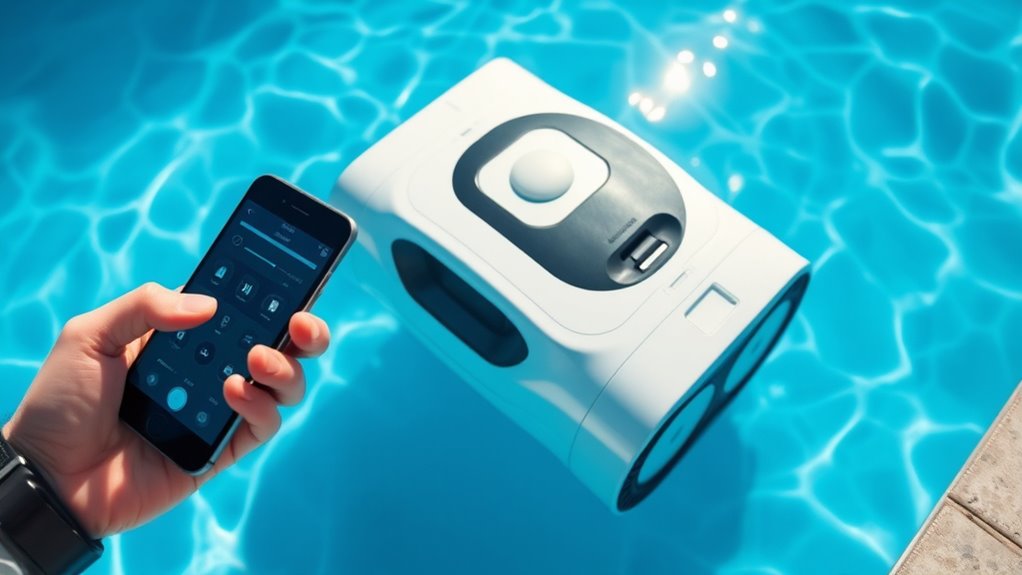
If your robotic pool cleaner isn’t responding as expected, the issue might stem from connectivity problems with the remote control or mobile app. First, check your remote connectivity by ensuring the batteries are fresh and the remote is within range. For app troubleshooting, restart your device and reopen the app, then verify that your Wi-Fi or Bluetooth connection is stable. Resetting the connection often resolves minor glitches—try turning off the cleaner, then reconnect via the app or remote. If issues persist, re-pair the device following the manufacturer’s instructions. Confirm that your firmware and app are up to date, as updates can fix bugs. Ensuring a strong, stable connection restores full control, preventing unnecessary operational hiccups. Additionally, understanding connectivity issues can help you diagnose and prevent future problems with your device, especially as automation technology continues to advance and integrate into household appliances. Regularly updating your device’s software can also help address software bugs that may affect connectivity and performance. Incorporating troubleshooting techniques and maintaining awareness of wireless interference can further assist in maintaining optimal device functionality.
Inspect and Clean the Brushes and Filters
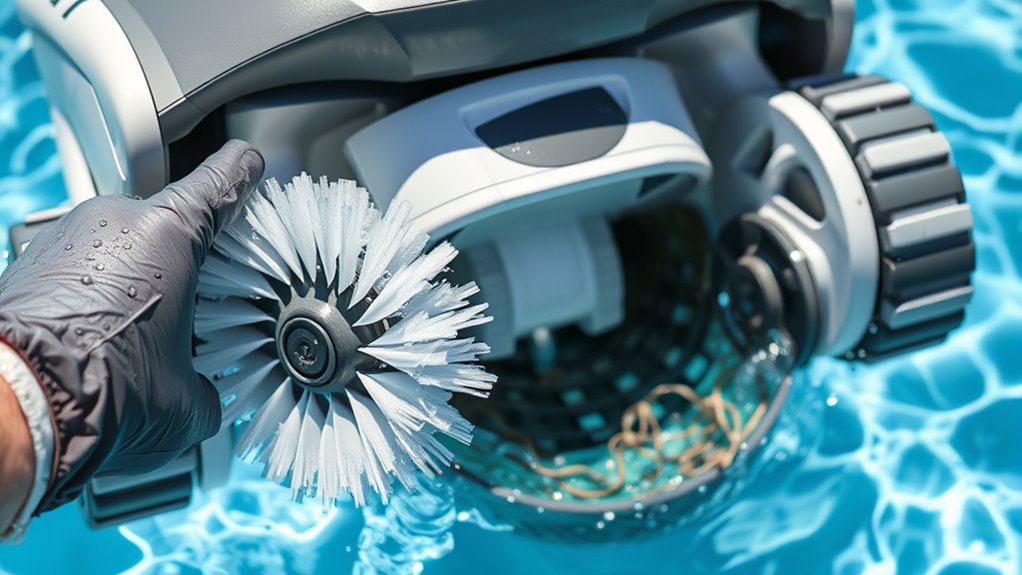
Start by removing and examining the brushes to check for wear or damage. Next, clear out any clogs from the filters to guarantee proper water flow. If parts look worn or damaged, replace them to keep your cleaner running efficiently. Regular maintenance, including inspecting system components, can help prevent costly repairs and prolong the lifespan of your robotic pool cleaner. Additionally, inspecting Glycolic Acid benefits such as collagen production and skin texture can optimize your skincare routine and overall skin health. Incorporating preventative maintenance strategies can further ensure your device remains in top condition, reducing the likelihood of unexpected failures and routine inspections are vital for early detection of potential issues.
Remove and Examine Brushes
To guarantee your robotic pool cleaner operates efficiently, you should regularly remove and examine its brushes and filters. Start by carefully detaching the brushes to check for tangled hair, debris, or wear. Proper brush maintenance is essential to ensure maximum cleaning performance. If you notice significant signs of damage or worn bristles, it’s time for brush replacement. While inspecting, clean any buildup or debris to prevent clogging and improve brush movement. Regularly removing and examining these parts helps extend your cleaner’s lifespan and maintains its scrubbing power. Additionally, understanding how self-watering plant pots work can provide insight into the importance of proper reservoir maintenance, which is similar to keeping your pool cleaner in optimal condition. Remember, neglecting brush maintenance can reduce cleaning efficiency, so make it a routine part of your pool care. Keeping your brushes in top shape with regular inspections can prevent performance issues and save you time and money in the long run, especially since effective cleaning components depend on well-maintained parts. Performing routine maintenance tasks regularly ensures your cleaner continues to operate at peak performance and prevents costly repairs. Incorporating proper cleaning techniques can further optimize your pool cleaning process and extend the life of your equipment.
Clear Clogged Filters
After inspecting and cleaning the brushes, it’s important to examine the filters for any clogs or debris that could hinder your cleaner’s performance. Proper filter maintenance ensures peak operation and prevents unnecessary strain on the motor. To do this, follow these steps for clog removal:
- Remove the filter housing cover carefully.
- Take out the filter and check for tangled hair, leaves, or dirt.
- Rinse the filter under running water to clear debris.
- Use a brush or cloth to scrub away stubborn grime if needed.
- Regularly inspecting and maintaining filters can help prevent performance issues caused by performance tuning limitations or blockages.
- Maintaining clean filters also contributes to indoor air quality and overall system efficiency.
- Periodic inspection of filters helps identify signs of wear or damage, ensuring timely replacement and optimal operation. Regular filter maintenance is essential for preventing clogging and ensuring consistent cleaning performance.
- Inspect the filter closely for wear or damage. Regularly cleaning and maintaining filters helps keep your robotic pool cleaner running smoothly and extends its lifespan. Incorporating advanced filtration technology can further improve debris removal and system longevity. Clog removal is a simple but essential part of maintenance.
Replace Worn Components
Regularly inspecting and cleaning the brushes and filters helps guarantee your robotic pool cleaner operates efficiently. Worn components, like brushes and filters, can reduce cleaning performance and cause unnecessary strain on your device. If you notice signs of wear, such as frayed bristles or damaged filters, it’s time to replace the parts. Using the correct replacement parts ensures your cleaner functions properly and extends its lifespan. Don’t delay replacing worn components, as neglect can lead to more significant issues or complete failure. Keep a set of spare replacement parts handy, and routinely check the brushes and filters for signs of deterioration. Additionally, understanding the suction power and cleaning modes of your device can help you identify when maintenance is needed to maintain optimal performance. Regular maintenance, including proper component replacement, can significantly improve the overall longevity of your robotic cleaner. Being aware of support hours and service options can also help when seeking assistance for troubleshooting complex issues.
Examine and Clear the Robot’s Path and Sensors
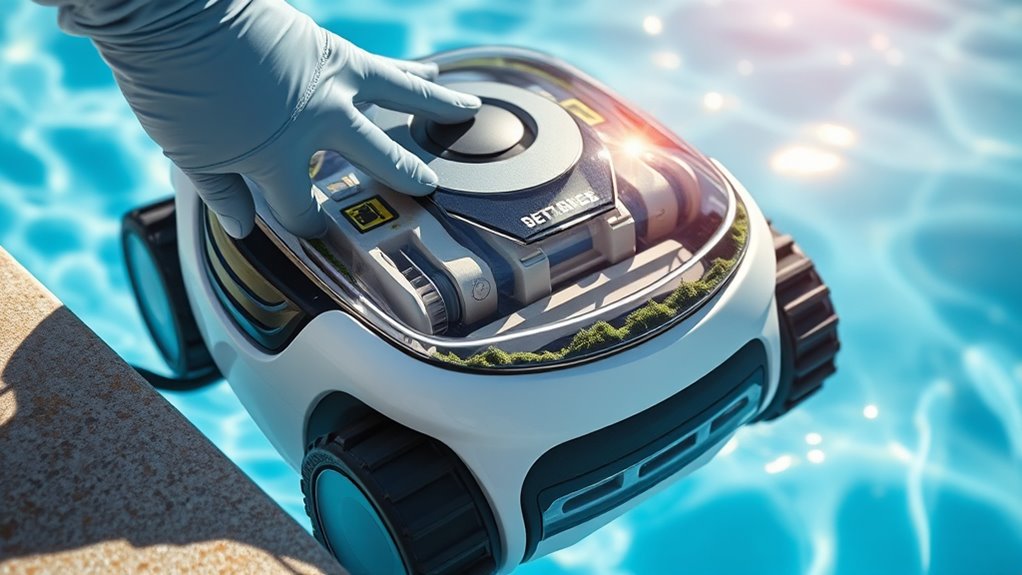
When your robotic pool cleaner isn’t functioning properly, examining its path and sensors is a crucial first step. Start by inspecting the sensor calibration to guarantee accurate obstacle detection. Then, check for debris or obstructions that may block the sensors, affecting navigation. Next, look at the robot’s path for the following issues:
- Clutter or debris on the robot’s wheels or brushes
- Objects or leaves stuck on sensors
- Uneven surfaces or obstacles in the pool
- Sensor alignment or dirt buildup that impairs detection
Cleaning sensors gently with a soft cloth can restore proper obstacle detection. Clear any debris blocking the sensors, and verify that the robot’s path is free of obstructions to improve operation and avoid navigation errors.
Troubleshoot Battery Life and Charging Issues
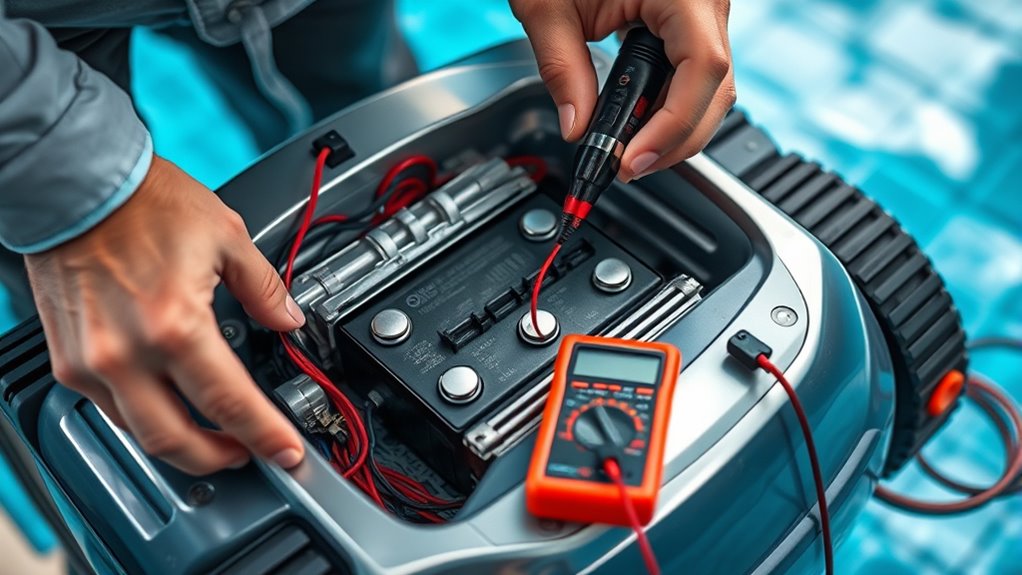
If your robotic pool cleaner isn’t holding a charge or isn’t running as long as it used to, troubleshooting the battery and charging system is essential. Start with proper battery maintenance by ensuring the battery contacts are clean and connections tight. Check the charging station placement; it should be in a shaded, dry area away from obstacles to optimize charging efficiency. Also, verify that the robot is seated correctly on the charger. If issues persist, consider replacing the battery or charger. Proper care prolongs battery life and improves performance.
| Battery Maintenance | Charging Station Placement |
|---|---|
| Clean contacts regularly | Position in shaded, dry location |
| Avoid exposure to water or debris | Keep clear of obstacles for effective charging |
| Use recommended batteries | Ensure robot is properly seated on charger |
| Monitor battery health periodically | Check wiring and connections for damage |
| Replace when capacity declines | Adjust placement if charging issues occur |
Address Stuck or Jammed Moving Parts
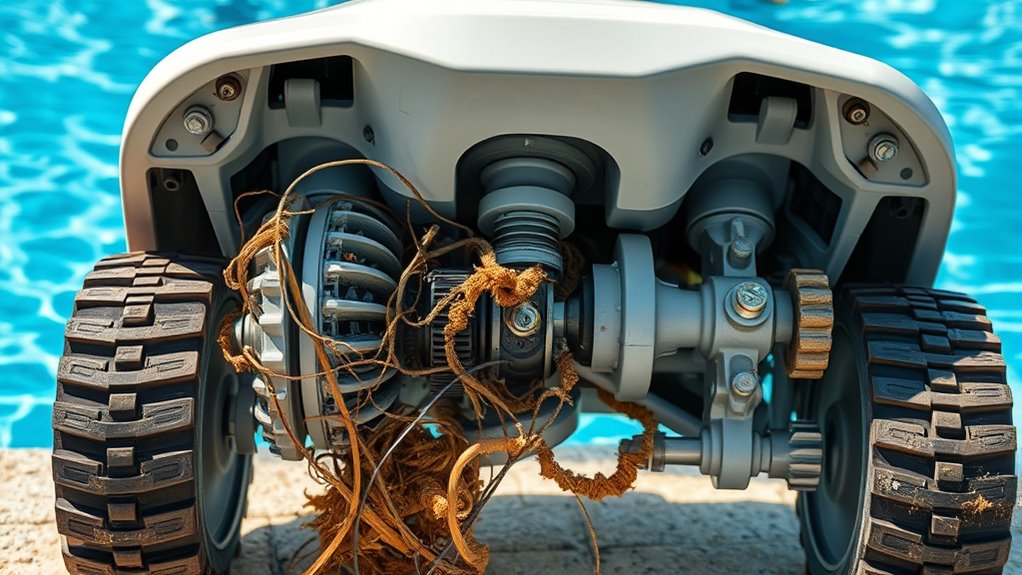
Stuck or jammed moving parts can hinder your robotic pool cleaner’s performance, but quick action can often resolve the issue. First, turn off the cleaner and inspect the brushes and wheels. Next, check for debris or tangled cords that could block movement. Then, examine the motor alignment to ensure parts are correctly positioned. Finally, lubricate the gear mechanisms to reduce friction and prevent future jams. Imagine:
- Clearing hair and dirt from the brushes and wheels.
- Realigning the motor if it’s shifted.
- Applying proper gear lubrication to smoothen operation.
- Ensuring nothing is obstructing the moving parts.
Addressing these areas promptly restores smooth movement, preventing further damage and keeping your pool spotless.
Ensure Proper Placement of the Robot in the Pool
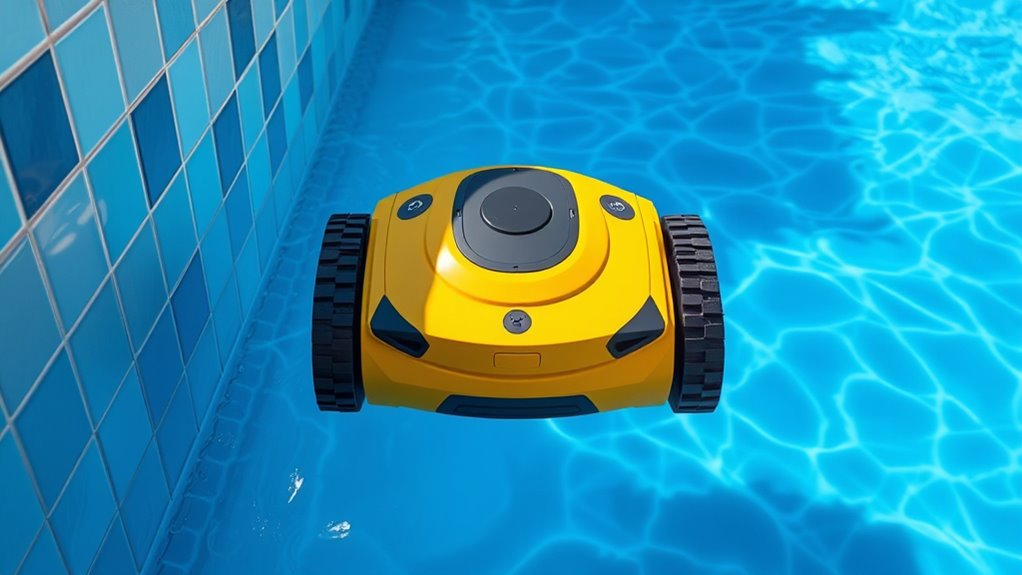
Make certain your robotic cleaner is correctly positioned in the pool to work efficiently. Keep the area free of obstructions and debris that could hinder its movement. Proper placement ensures thorough water coverage and ideal cleaning performance.
Correctly Position the Robot
Positioning your robotic pool cleaner correctly is essential for it to operate effectively. Place the robot in a spot where it can access the pool’s main areas without obstructions. Imagine:
- Setting it near the shallow end for even coverage.
- Ensuring it’s not tangled with cords or pool toys.
- Positioning it on a clean surface free of debris.
- Confirming the water chemistry isn’t too imbalanced, which can hinder movement.
A proper robotic cleaning schedule helps maintain clarity, but correct placement maximizes efficiency. If the robot starts in the right spot, it can cover more area, reducing missed spots. Keep the pool water chemistry balanced to prevent slipping or sticking. Good placement ensures consistent cleaning and prolongs the robot’s lifespan.
Avoid Obstructions and Debris
Placing your robotic pool cleaner in a spot free of obstructions and debris guarantees it can operate without interruptions. Clear the pool floor of leaves, toys, and other debris that could block the robot’s movement or clog its filters. Make sure the area isn’t cluttered with pool accessories or equipment that might interfere with coverage. Proper robot storage when not in use helps prevent accidental damage and keeps the device clean, ready for its next run. Maintaining good pool chemistry, like balanced pH and chlorine levels, also reduces debris formation and prevents the robot from getting stuck or dirty quickly. By ensuring the robot is placed in an unobstructed area and stored properly, you extend its lifespan and improve cleaning efficiency.
Ensure Proper Water Coverage
To guarantee your robotic pool cleaner covers the entire pool effectively, you need to place it in the right location. Proper placement ensures ideal water flow, which influences coverage patterns. Position the robot away from obstructions and pool walls, allowing it to move freely. Picture these key spots:
- Center of the pool, where water flow is strongest.
- Near the main drain, to maximize coverage.
- Away from ladders or steps that could block movement.
- Clear of floating debris that might hinder navigation.
Reset the Robot to Factory Settings
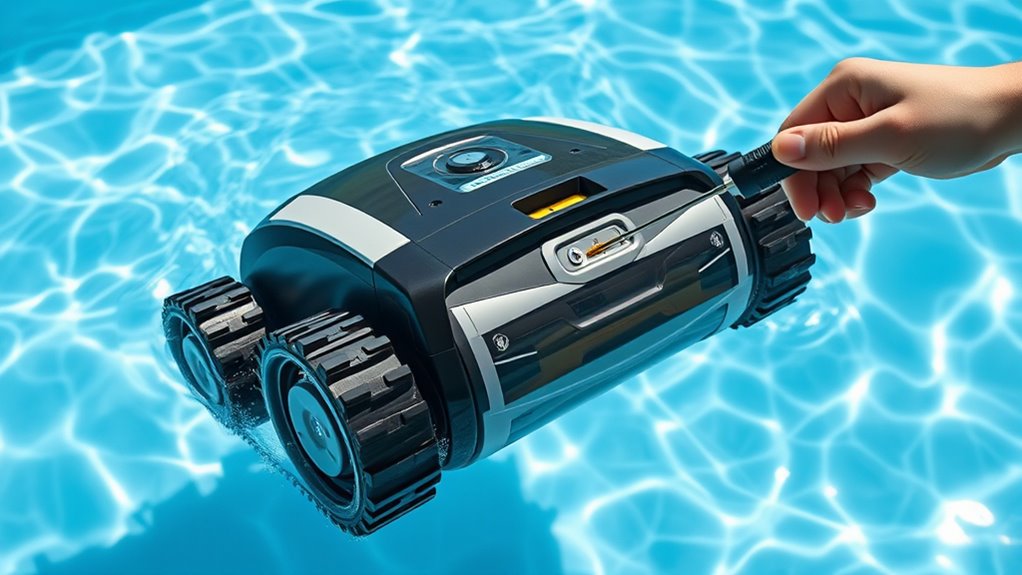
Have you tried resetting your robotic pool cleaner to its factory settings? Performing a factory reset can often resolve issues caused by incorrect configurations or software glitches. To do this, locate the reset button or follow your model’s specific instructions in the user manual. Press and hold the reset button for the recommended time, usually around 10 seconds, until you see a lights or hear a sound indicating the reset. This process restores your robot’s settings to default, providing a clean slate for troubleshooting. Keep in mind, a factory reset doesn’t delete your saved programs but reverts all other settings to their original state. Use this step as a quick fix before attempting more advanced troubleshooting steps or updates.
Update Firmware or Software If Available
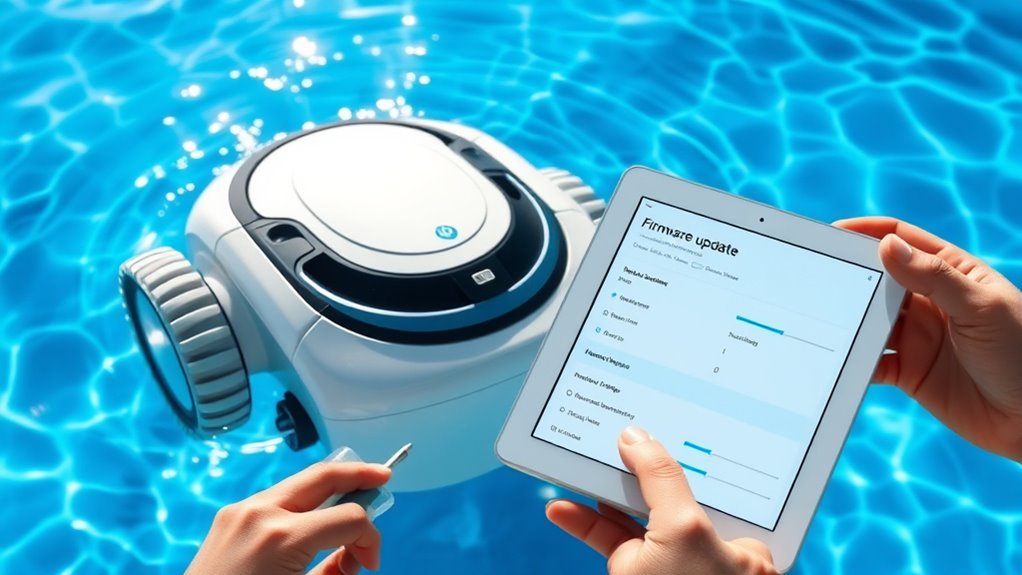
After resetting your robotic pool cleaner to factory settings, the next step is to make certain it’s running on the latest firmware or software version. Firmware updates and software upgrades can fix bugs, improve performance, and add new features. To do this:
- Turn on your device and connect it to your Wi-Fi network.
- Open the manufacturer’s app or control panel.
- Check for available updates with a tap or click.
- Follow prompts to download and install the latest firmware or software upgrade.
During this process, guarantee your device remains connected and powered. Updating firmware or software often resolves common issues and keeps your cleaner functioning smoothly. Regular updates are key to extending your robot’s lifespan and maintaining peak performance.
Contact Customer Support for Persistent Problems
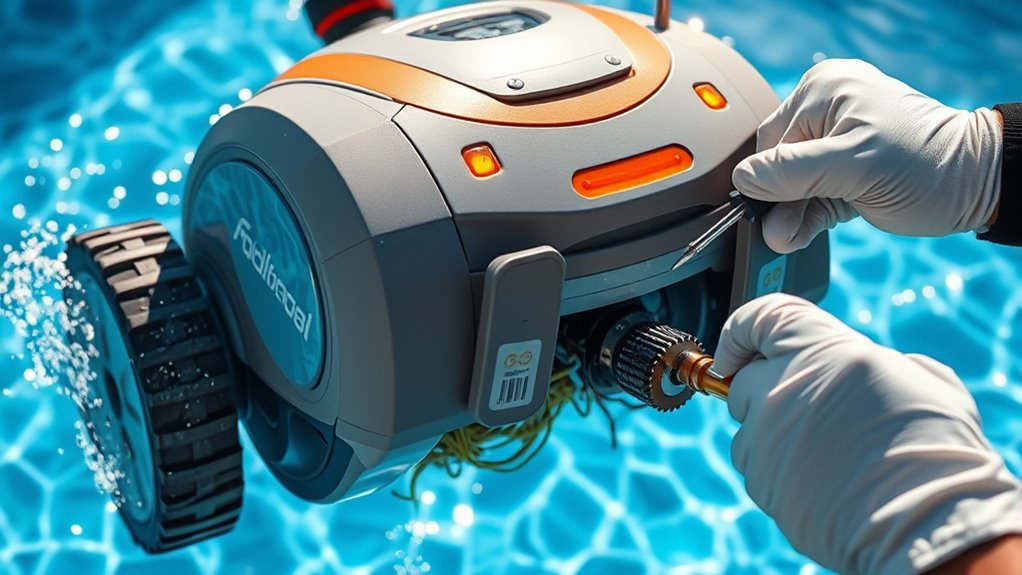
If troubleshooting steps haven’t resolved the issue, reaching out to customer support is often the best course of action. Persistent problems like recurring software glitches or unclear operation often require expert assistance. Before contacting support, review your user manual thoroughly to guarantee you’ve followed all recommended procedures. When you connect with customer support, describe the problem clearly, including any error messages or unusual behavior. They can guide you through advanced troubleshooting steps or determine if your robotic pool cleaner needs repairs or replacement. Don’t hesitate to ask about firmware updates or specific software issues, as these are common causes of ongoing problems. Remember, customer support exists to help you get your cleaner back in working order quickly and efficiently.
Frequently Asked Questions
How Can I Improve the Robotic Pool Cleaner’S Cleaning Coverage?
To improve your robotic pool cleaner’s coverage, start by adjusting its cleaning schedule to guarantee consistent operation. Consider your pool size and select a cleaner with appropriate capacity; larger pools need longer or more frequent cleaning cycles. Regularly clear the filter and remove debris to prevent obstructions. Additionally, reposition the cleaner for ideal access to all pool areas, and check for obstacles that could hinder its movement, ensuring thorough cleaning every time.
What Should I Do if the Robot Randomly Stops During Operation?
If your robotic pool cleaner randomly stops during operation, first check for power supply issues like loose connections or low voltage. Next, examine the sensors for malfunctions or debris that might interfere with their functioning. Make certain the power source is stable and all connections are secure. Clearing any obstructions and resetting the cleaner can also help. Addressing these issues promptly keeps your cleaner running smoothly and prevents unnecessary interruptions.
Is It Normal for the Robot to Make Noise While Cleaning?
Did you know that robotic pool cleaners can produce up to 70 decibels of noise during operation? It’s normal for your robot to make cleaning sounds and some noise while working, especially when brushing or steering. Don’t worry—these sounds are part of its cleaning process. If the noise becomes unusually loud or strange, it might indicate a problem. Otherwise, your robot’s noise level is typical and signals it’s doing its job.
How Do I Troubleshoot if the Robot Is Not Detecting the Pool’S Walls?
If your robotic pool cleaner isn’t detecting the pool’s walls, start by checking its sensor calibration. Make sure the sensors are clean and properly aligned, as dirt or misalignment can hinder obstacle detection. You can also manually test obstacle detection by placing the robot near the wall and observing if it reacts. If it still doesn’t detect the wall, resetting the sensors or updating the firmware might help improve its wall detection capabilities.
Can Debris Damage the Robot’S Internal Components?
Debris can definitely damage your robot’s internal components if not managed properly. Regular robotic maintenance and debris prevention are key. You should check and clear filters frequently, avoiding large or sharp debris that could cause internal damage. Keep the robot clean and free of obstructions, and inspect it after each use. Doing so helps prevent debris from causing costly repairs and ensures your pool cleaner functions smoothly.
Conclusion
By following these troubleshooting steps, you’ll keep your robotic pool cleaner sailing smoothly like a well-oiled machine gliding through crystal-clear water. Think of it as tending to a loyal underwater assistant, ensuring it stays in prime condition and ready to tackle dirt and debris. When issues arise, don’t let frustration build up—treat each problem as a small wave to ride over. With patience and care, your cleaner will keep your pool sparkling, just like a mirror reflecting sunshine.

